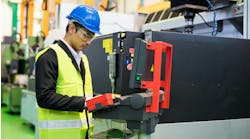It’s often said that data—and the sensors that capture it—are the foundation of Industry 4.0.
But in between those raw, real-time inputs about industrial processes and the agile, more fully informed decisions required to fulfill the promise of digital transformation is a tremendous amount of heavy lifting. And it’s in this industrial integration space that SICK AG, the global sensor manufacturer is making good on its longstanding brand promise of “Sensor Intelligence."
In place since 2004, this slogan has a precise meaning and continues to inform the company’s focus, according to Dr. Robert Bauer, chairman of the executive board, who addressed in January a gathering of trade journalists at the company’s headquarters of Waldkirch, a hamlet nestled in southwestern Germany’s Black Forest region. “Just as a railway station is first and foremost a station, our focus is on the intelligence enabled by the sensor,” Bauer said. “Intelligence is the only way to Industry 4.0.”
“Industrial automation and Industry 4.0 are two sides of the same coin.” SICK AG’s Robert Bauer revealed how the sensor specialist has grown into a leading supplier of the industrial integration technologies needed to make digital transformation a reality.
That’s not to say that the company is neglecting its core sensor technologies (the portfolio of which now numbers some 40,000 products), but investments in infrastructure, data-driven services and applications such as the SICK AppSpace, where software combines sensor data with other sources of information, represent a significant portion of the company’s R&D effort. At €169 million in 2017 research spend, the company invests more than 11% of sales revenue (€1.512 billion in 2017) back into its next generation technology and services offerings.
“Our core business is in industry, in the automation of factories, processes and logistics,” added Bauer. “But industrial automation and Industry 4.0 are two sides of the same coin.”
Industry 4.0 in action
SICK takes the principles of Industry 4.0 to heart, and is applying them to its own manufacturing facilities. At the upcoming Hannover Messe in April, show goers with have the opportunity to peer into the operations of the company’s new “4.0 NOW” smart production facility in Freiburg—over 600 km away from the Hannover fairgrounds. Live, streaming video will show automated guided carts (AGCs) as they make their rounds, shuttling raw materials and components to automated production cells and carrying finished products away.
“It looks so simple, but it’s the result of concentrated development and networking efforts,” said Bernhard Müller, senior vice president of Industry 4.0, SICK AG. “All of our vehicles, components and production cells are connected to each other and upload data to a cloud. Production can be scaled to match the order situation and requirements. Automated operations are carried out alongside manual work. The advantages of both methods are combined to make production efficient,” said Müller.
At SICK’s new “4.0 NOW” smart production facility in Freiburg, Germany, automatic guided vehicles work together with human operators to shuttle in-process assemblies among a network of highly automated work cells in the most efficient way possible.
As a manufacturer of sensors, SICK AG has been supplying the basics for data generation for decades. “But we want to show our visitors at Hannover Messe 2019 how production and logistics can be networked and how data transparency can boost value creation potential. And it all happens in real time,” said Müller.
During the January press event, SICK also showed off its Outdoor Technology Center where, since summer 2018, the company has been proving out real-world applications of its systems, together with its customers. The 3,500-m2center, colocated with one of the company’s distribution facilities in Freiberg, includes a small test oval for autonomous vehicle applications and a simulated train station for the company’s traffic safety solutions. Long-term testing of perimeter protection, environmental monitoring and motor feedback systems also is conducted here.
Localization, edge computing, deep learning
Among the range of new systems to debut this year that demonstrate SICK’s commitment to the Industry 4.0 solutions space are real-time location tracking, or localization, systems; edge-computing solutions that combine multiple intelligent sensors into highly capable, cloud-connected systems; and sensor systems that leverage deep learning algorithms for maximal application flexibility.Localization technology is one of the key factors in achieving the type of networked production and logistics needed for Industry 4.0, explained SICK’s Bernhard Müller. “Localization data results in a high level of transparency and understanding of all production-related assets, load carriers and loading equipment.”
The payoff of knowing where everything is at any given time? Travel paths can be optimized and adapted dynamically. Equipment setup can be done just-in-time, or rescheduled flexibly. Material flows can be planned and controlled based on consumption. All of this boosts delivery quality and on-time delivery. And it’s all fully automated. “By offering this solution, we’re doing more than just answering the question of how to make I4.0 a reality. We’re achieving high-efficiency logistics and production that live up to the standards of both the customers and the ever-changing market,” explained Müller.
The company also is introducing two new members of the Sensor Integration Machine, or SIM, product family. The SIM1004 and SIM1012 extend and scale the SICK SIM product family portfolio in terms of processing power and number of sensor connections. In the SIM1004 basic model, four connections allow combined data processing from two cameras or a laser scanner, for example. With correspondingly higher scaling, the SIM1012 has twelve connections for the next level of complexity. Both variants can crunch data locally at the edge, and come “cloud-ready” with Ethernet interfaces and OPC-UA and MQTT communication protocols.
SICK will also introduce at Hannover Messe its first sensor systems that operate on the basis of deep-learning algorithms. Suitable sensors are available for a large number of standardized applications, but there is an increasing demand for customized products in response to the growing need for individual solutions.
“Up until just a few years ago, manufacturers tried to develop new sensors products to meet every requirement,” said Müller. Indeed, to bring solutions to market faster, the company already offers the SICK AppSpace eco-system that permits realization of flexible solutions for automation applications
But the sensor manufacturer is now going one step further, and using deep learning technology to specialize the functionality of its sensors. For example, in order to ensure optimum use of raw lumber, sawmill operators must understand the grain patterns in the logs. “In order to find out how the lumber can be used best, we taught the camera this by means of deep learning. This task could previously be performed only by humans,” explained Müller.
This deep-learning technology makes it possible to realize new, previously inconceivable applications that make processes more efficient and more productive. “In our pilot project, we were able to increase the material utilization, improve the quality of the products and avoid wasting resources,” continued Müller. An added benefit is that employees no longer have to perform monotonous activities and are free to take on more complex tasks.






